This website uses cookies to improve your browsing experience and analyze the use of the website. Learn More

Reserve Your Spot with Confidence! Full Refunds with 24 Hrs Notice. Reschedule at any point, even after tour, if space allows!
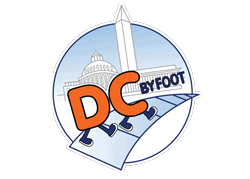
How to Tour the Supreme Court

This post covers how to attend a U.S. Supreme Court tour as well as courtroom lectures and oral arguments with tips on how to plan your visit and what you might see.
- Where is the Supreme Court
- Guided Tours + Exhibits
- Courtroom Lecture
- Attend a Supreme Court Case
- Visit the US Capitol and Library of Congress
- Other Things to Do in DC
HOW TO GET TO THE SUPREME COURT
The Supreme Court Building is located at 1 First Street St NE across the street from the US Capitol Building and the Library of Congress.
Use this link for directions to the Supreme Court .
Or let us take you here on one of our pay-what-you-like Capitol Hill Tours .
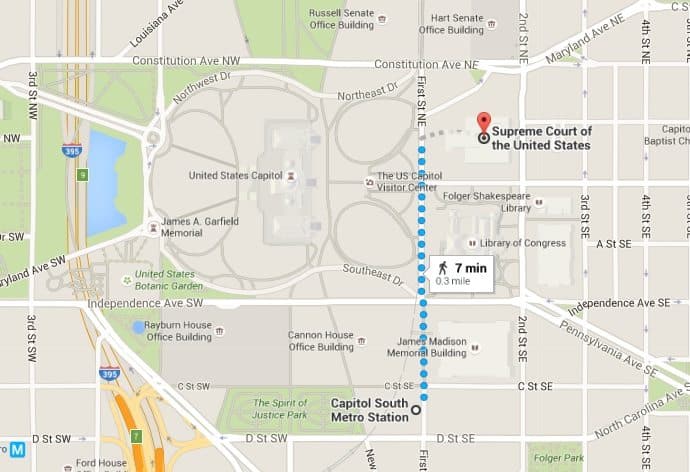
It is a 7 min walk from the Capitol South Station Metro ( Blue , Orange , Silver ). Exit the station and continue north on First Street for two blocks.
It is also about a 15-minute walk from Union Station ( Red ), which has a paid parking garage.
If you are new to DC's subway system, then read our guide on how to use the DC Metro system .
There are no parking facilities at the building. Street parking is very limited. You can reserve a space at nearby commercial garages through a service called SpotHero .
Supreme Court Hours:
The Supreme Court is open on weekdays 9 am - 3 pm , excluding Federal Holidays. The building is not open on the weekend.
Like most federal buildings, you will be required to enter through security. There are two doors on either side of the main steps on the plaza level to enter the building.
Prohibited items include weapons and other dangerous items.

SUPREME COURT TOURS + CURRENT EXHIBITS
The Supreme Court currently does not offer guided tours; visitors are encouraged to tour the building independently ( or on a tour with us !).
In reality, visitors are limited to only the public portions of the building, which are mostly the exhibits on the ground floor as well as the Main Hall on the 2nd floor.
There are several opportunities to visit the main courtroom (see below sections on attending a court lecture or to hear a case ).
Once through security, you will be on the ground floor.
Here you will find a 24-minute film that covers the history of the building, with interviews with the Chief Justice as well as Associate and former Justices.
It's on this floor where you will also find the current exhibitions .
- The Supreme Court Building: America's Temple of Justice
- Reading the Law: Legal Education in America
- Sandra Day O'Connor, First Woman on the Supreme Court
- The Power of Image: Charles Evans Hughes in Prints, Photographs, and Drawings
- Capturing Justice: Judicial Portraits by Augustus Saint-Gaudens
Supreme Court Building Tours
We are able to offer small group private tours that visit inside the Supreme Court on private versions of our Capitol Hill & Library of Congress Tour!
This 2 hour tour would tour inside the Supreme Court Building, inside the Library of Congress & end with tickets to tour inside the Capitol Building with their professional docents (this tour would be an additional 50 minutes to our 2 hour tour)
Our almost twice-a-day public version of this tour does not guarantee entrance into the Supreme Court (though sometimes we can visit inside based on security and opening). On private tours, we can schedule it to ensure we can go inside the Supreme Court.
Contact us to book a private Capitol Hill tour that enters the Supreme Court!
HOW TO ATTEND A SUPREME COURT LECTURE
Since this is a working federal building, you are limited as to where you can go on your self-guided tour.
The only way to visit the courtroom is by attending a docent lecture or attending a case.

You can read about attending a case below but if you are visiting on a day that the court is not hearing a case, you can still have a seat in the courtroom and listen to the history of the court and the building.
30-minute courtroom lectures are held every half-hour from 9:30 am to 3:30 pm.
Seating is first-come, first-served, so during the busy spring and summer months, expect to get there early to wait in line.
For the most up-to-date information on when lectures are scheduled, visit the lecture calendar .
HOW TO ATTEND A SUPREME COURT ORAL ARGUMENT
While you can visit the Supreme Court courtroom as a visitor for lectures, cases are also open to the public.
Called Oral Arguments, these are the 1-hour long sessions where each side is allowed 30 minutes to argue before the court.
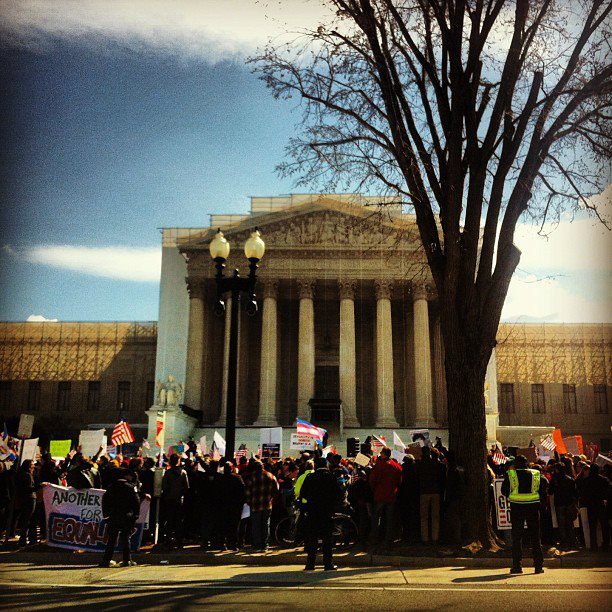
From the first Monday to October to Mid-April, cases are generally heard on Mondays, Tuesdays, and Wednesdays at 10 am and at 11 am, with additional afternoon sessions as needed.
There are two ways to attend a Supreme Court case.
You could either secure a seat and witness the entire Oral Arguments, or you can catch a quick 3-minute glimpse of the proceedings. (the 3-minute line is suspended still as of Feb 2024)
These two lines form on the plaza before each case.
For a landmark Supreme Court case, some people will line up days in advance to guarantee a spot. On a non-high-profile day, people arrive around 6 am-7 am.
Normally, only the first 50 are able to get in for the entire session.
Numbered tickets are given out prior to seating to allow you time to go to the restroom, cafeteria, and cloakroom.
If you don't get a seat , you can also do a walk-through where you stay for a few minutes and then move on. You can rotate through as many times as you'd like by getting back in line. (This is not an option as of Feb 2024. We hope it returns soon!)
You can also attend Bench Mondays (Mondays, 10 am, mid-May through June) to hear the court opinions and decisions.
These are about 15 - 30 minutes long, but can also form long lines for high-profile cases.
To see what cases are being argued, visit the Argument Calendar.
SUPREME COURT JUSTICES
How many justices are on the Supreme Court?
There are 9 Supreme Court Justices in total: 8 associate justices and one Chief Justice.
How do you become a Supreme Court Justice?
There are only two requirements to be a Supreme Court justice. It is not based on age, citizenship, or experience.
You must be nominated by the President and approved by Senate. It is a lifetime appointment that one holds until they retire.
Who is the Chief Justice of the Supreme Court?
The Supreme Court Chief Justice is a position appointed by the President, so it is not relevant to the length of time they serve on the court.
The current Supreme Court Justice is John Roberts.

Who are the current Supreme Court Justices?
- Clarence Thomas (1991)
- John Roberts (2005
- Samuel Alito (2006)
- Sonia Sotomeyer (2009)
- Elena Kagen (2010)
- Neil Gorsuch (2017)
- Brett Cavanaugh (2018)
- Amy Coney Barrett (2020)
- Ketanji Brown Jackson (2022)
VISIT THE U.S. CAPITOL BUILDING AND THE LIBRARY OF CONGRESS
Why not make a half-day of it and visit both the U.S. Capitol Building as well as the Thomas Jefferson Building of the Library of Congress?
Both are adjacent to the Supreme Court Building.
You could also have lunch at the Capitol Visitor Center.
For more information on visiting and touring both buildings, click on the links below.
- U.S. Capitol Building
- Library of Congress

Choose a Destination... I want them all PLUS general travel tips. Amsterdam Berlin Boston Charleston Chicago Dubai Lisbon London Los Angeles Miami Nashville New York City New Orleans Paris Philadelphia Prague Rome San Francisco Washington DC
About The Author

Canden Arciniega
North america, united kingdom & ireland, middle east & india, asia & oceania.

- San Antonio
- St. Augustine
- Washington DC
- Home Main nav menu item
- MAP & STOPS Main nav menu item
- Things to DO Main nav menu item
- SCHEDULE Main nav menu item
- FAQS Main nav menu item
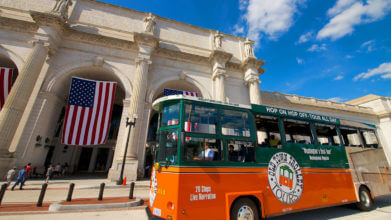
☆☆☆☆☆
★★★★★
812 reviews
Old Town Trolley Tours Washington DC 4.2
U.S. Supreme Court
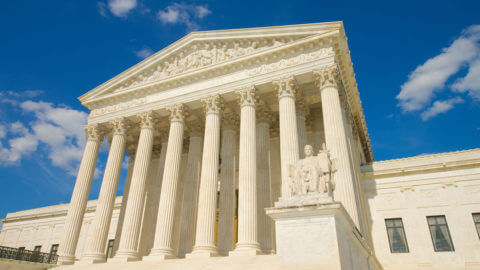
Upon arrival at the Supreme Court, visitors are often struck by the imposing marble building. Architecturally magnificent, the neoclassical structure was built in 1935 to become the permanent home to the Supreme Court. Walking along the hallway towards the Courtroom, guests are greeted by busts of all the former Chief Justices. The Supreme Court is the highest judiciary authority in the United States and hears about 100 cases each year, although more than 7,000 are submitted before them. Visitors can tour the Supreme Court building, hear lectures on the history of the court and how it works, sit in on sessions on specified days and times and view various exhibits throughout the year.
Despite its central role as one of the three main branches of government outlined in the U.S. Constitution, the Supreme Court did not have its own venue to conduct business for the first 145 years of its existence. The Court initially met in the Merchants Exchange Building while the capital was located in New York. When the nation’s capital moved to Philadelphia beginning in 1790, the Court met in Independence Hall and City Hall. With the establishment of the federal city 10 years later, the Supreme Court occupied chambers in various parts of the Capitol Building. It would also convene in a private residence for a short time after British soldiers burned Washington, D.C. during the War of 1812. The Court would return to the Capitol and occupy the Old Supreme Court Chamber from 1819 until 1860. With expansion of the Capitol, the Court was relocated and convened in the Old Senate Chamber from 1860 until 1935.
Brief History of the Supreme Court Building
Former president and then Chief Justice of the Supreme Court, William Howard Taft persuaded Congress in 1929 to authorize the construction of a separate building for the Court. Architect Cass Gilbert was selected to design the new federal building. The construction project began in 1932. Neither Taft nor Gilbert survived to see the completed building, which was finished in 1935. Chief Justice Charles Hughes and Cass Gilbert, Jr. oversaw the construction of the new Courthouse, which was completed under budget.
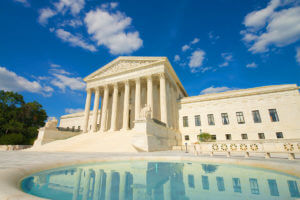
The Supreme Court Building occupies a site that was once the setting of the Old Brick Capitol, which served as a temporary capitol from 1815 until 1819. The building was also a private school boarding house and prison. It was razed in 1929 to make room for the new Supreme Court Building. A basketball court on the building’s fifth floor is colloquially known as “the highest court in the land.” The Supreme Court Building is one of only a few buildings designated as a National Landmark that is not listed on the National Register of Historic Places .
Must See Exhibits
The Supreme Court Building does not offer guided tours. You are encouraged to view the public spaces at your own pace. The exterior grounds as well as portions of the ground and first floors are open to the public. The building’s main façade faces west toward the U.S. Capitol . The main plaza includes fountains, flagpoles and benches as well as marble candelabra depicting “Justice” holding a sword and scales. A bas-relief sculpture of the Greek deities known as the Three Fates knit the thread of life. The base of each flagpole contains symbolic designs of scales, a sword, pen and book as well as the elements of earth, air, water and fire.
Two sculptures of seated figures by James Earle Fraser flank the main entrance. While the female figure entitled Contemplation of Justice is situated on the left, the male figure Guardian of Authority is found on the right. The 6.5-ton bronze doors depict historic scenes from the development of law created by John Donnelly, Jr. Above the entrance is the inscription “Equal Justice Under Law.” On the east side of the building, there are several sculptures of famous lawgivers by Hermon MacNeil. These include Confucius, Moses and Solomon. The east façade bears the inscription “Justice, the Guardian of Liberty.”
Inside the building, visitors can tour the Great Hall. It features busts of former chief justices and friezes depicting heraldic devices and profiles of famous lawgivers. The most famous is the 1883 bust depiction of John Marshall by William Wetmore Story. It stood on the west lawn of the Capitol until it was relocated in 1981. You can also see two five-story self-supporting bronze and marble staircases. The Court Chamber features 24 imported Italian marble columns as well as sculpted marble panels of famous lawgivers and legal themes.
Seating during oral arguments and other proceedings in the courtroom are available to a limited number of guests on a first-come, first-served basis. Various lectures, films and court-related exhibits are offered throughout the day. Docents present lectures about the courtroom that last approximately 30 minutes. The lectures start at the bottom of the hour when the court is not in session.
Know Before You Go
The Supreme Court Building is open Monday through Friday from 9 a.m. until 4:30 p.m. with the exception of federal holidays. It is closed Saturdays and Sundays. Portions of the building may be cordoned off when Court is in session. Visitors pass through security and enter the building from the plaza located beside the main steps. Admission is free of charge. The largest crowds gather from March through June . Because the building contains working offices, visitors are asked to tour as quietly as possible. Video and still photography are prohibited. Eating and drinking are only allowed in the cafeteria. The closest Metro stops are Capitol South on the Orange, Blue and Silver lines and Union Station on the Red line
Attractions Nearby
Library of Congress
Featured in scenes of the film “National Treasure: Book of Secrets,” the Library of Congress is the oldest cultural institution in America. You can take a one-hour docent-led guided tour of the Thomas Jefferson Building to learn about the building’s art and architecture. The narration also includes information about the Library’s history and collection as well.
U.S. Capitol
A symbol of American democracy across the globe, the U.S. Capitol is among the most architecturally impressive buildings in the country. During public tours, visitors can learn about its history as well as view the Rotunda and the Crypt along with sculptures, paintings and other works of art.
Upper and Lower Senate Park
Adjacent to the north portico of the Capitol, Upper and Lower Senate Parks feature landscaped gardens, a reflecting pool and fountains. You can enjoy shade tree-lined pathways, memorials and the historic Summerhouse.
DC Old Town Trolley Tour
Old Town Trolley is a convenient way to explore the Supreme Court while maximizing your vacation time. Upon this lofty perch sits the iconic marble facade where the most important legal decisions in the United States are made. Find the lowest price packages by purchasing tickets direct through our website.
You may also like...
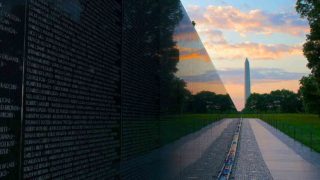
Live, Virtual Capitol Tour
Join one of our knowledgeable guides for a live, virtual tour of the Capitol. The tour includes the Crypt, Rotunda, National Statuary Hall, the Old Supreme Court Chamber, and the Old Senate Chamber. The tour will have live video and audio with time for questions and answers.
These online tours are available upon request by emailing [email protected] . Tours are 45-60 minutes, including time for questions and answers. Tour participation requires a device that plays sound and video. Participants will not be on camera and will submit questions via the chat feature.
To request an accommodation to participate in a Virtual Capitol Tour, please email your request to [email protected] at least 48 hours before your scheduled tour.

U.S. Supreme Court Tours and Information

U.S. Supreme Court Tours
Please note that the Supreme Court is currently closed to the public.
What do you need to know? Building Hours & Entrances Monday – Friday (except Federal Holidays) 9 a.m. – 4:30 p.m. Closed on Saturday and Sunday Visitors may enter the building from the Plaza doors located on each side of the main steps. A wheelchair accessible ramp is located along Maryland Avenue on the left side of the building. All visitors must pass through security screening before entering the building. During the months of March – June, visitors should anticipate longer wait times to enter the building due to larger crowds visiting the Nation's Capital. Location and Directions The Supreme Court of the United States is located on First Street NE between East Capitol Street and Maryland Avenue, adjacent to the U.S. Capitol and the Library of Congress. View area map. By Metro (Subway): The closest Metro stops are: Capitol South (Orange, Blue and Silver Lines, 0.3 miles) Union Station (Red Line, 0.5 miles). By Metro Bus: The Circulator (Navy Yard Line), 96, 97, and A11 buses all stop in front of the Supreme Court Building. The 32, 34, 36, and 39 buses stop at First Street and Independence Avenue, a two block walk from the Building. Additional information on riding the Metro is available at the Washington Metropolitan Area Transit Authority. By Train: Amtrak, VRE, and MARC trains service Union Station, which is located approximately 0.5 miles from the Court. By Car: Street parking is extremely limited near the Supreme Court. The closest public parking garage is located at Union Station. Please note that the Supreme Court is not accessible by private bus or passenger van. Please see designated bus routes and restrictions. Cafeteria, Gift Shop, and Building Amenities A Cafeteria serving a variety of sandwiches, soups, salads, and beverages is open to the public from 7:30 a.m. until 4 p.m., Monday through Friday. A Gift Shop is located on the Ground Floor and is open from 9 a.m. until 4:25 p.m., Monday through Friday. The Gift Shop features extensive offerings of books and other instructive materials to enhance your understanding of the Court's history. Other offerings include educational games, learning aids, and gift items associated with the law and the Supreme Court. For your convenience, an ATM, public telephone (TTY/TDD), and vending machines are available on the Ground Floor. Public restrooms are located on the First and Ground Floors. Visitor Etiquette The Supreme Court is the highest court in the Nation for all cases and controversies arising under the Constitution or laws of the United States; therefore, visitors are asked to follow a few general guidelines. • Be prepared to pass through security screening at your point of entry. All items must be screened in x-ray machines and all visitors will be asked to pass through metal detectors. • Please tour the building quietly as working offices are adjacent to all public halls. Any visitors unable to maintain proper decorum will be asked to leave by the Supreme Court Police. • No photography or video recording is permitted inside the Courtroom. • Smoking is prohibited inside the building. • Consumption of food and beverages is permitted only in the Cafeteria and vending machine alcove. • Visitors may not touch portraits, busts, or other artifacts on exhibition. Accessibility Building Access and Parking Ramp access to the building is located along Maryland Avenue on the left side of the building. Limited handicap parking is also available along Maryland Avenue. Wheelchair Availability and Access A limited number of wheelchairs are available free of charge at your point of entry. Wheelchairs may be obtained from a Supreme Court Police Officer. Elevators are available throughout the building with access to all public areas. Assistive Listening Devices When Court is sitting, induction loop, FM and infra-red listening systems for the hearing impaired are available. Devices may be obtained from a Supreme Court Police Officer or Courtroom Attendant as you are being seated. Visitors' Film The film is accompanied by open captioning at each showing. TTY Telephone A wheelchair accessible, text telephone (TTY) is available in the vending machine alcove adjacent to the Maryland Avenue door. How do I get scheduled for a tour? Click here to vist the the Supreme Court website.
The Supreme Court does not provide guided walking tours, but visitors can tour the building on their own. Some popular highlights include the John Marshall Statue, portraits of Justices, and two self-supporting marble spiral staircases.
The Courtroom is located on the First Floor. Court sessions are open to the public. On days that the Court is not sitting, visitors can attend a 30 minute lecture to learn about the judicial functions of the Supreme Court, the history of the Building, and the architecture of the Courtroom. The lectures begin at 9:30 am with a final lecture at 3:30 pm. Check the lecture schedule by calling (202) 479-3211. The daily schedule is also posted at the Information Desk on the Ground Floor.
The Supreme Court also has exhibitions on the history of the building, the Justices and the work of the Court. All exhibitions and the theater are located on the Ground Floor. At the theater, you can watch The Supreme Court , a 24-minute film examining the history of the building. Showings are continuous from 9:15 am until 3:45 pm.
Related Attractions
Hours of operation.
The Supreme Court is open from 9:00 am to 4:30 pm, Monday-Friday. It is closed on Saturday, Sunday, and Federal Holidays.
Visitors may enter the Supreme Court from the Plaza doors located on each side of the main steps. See the image below showing the Visitor Entrance.
First Street NE between East Capitol Street and Maryland Avenue.
The Supreme Court is adjacent to the U.S. Capitol and the Library of Congress. Street parking is extremely limited near the Supreme Court. The closest public parking garage is located at Union Station.
How Can I Tour the Monuments & Memorials in Washington, DC?
No trip to washington, dc is complete without touring our celebrated monuments and memorials..
Touring DC’s iconic attractions
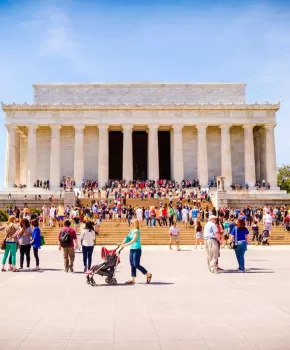
When you come to DC, especially if you’re a first-time visitor, it’s likely that our world-famous monuments and memorials will be at the top of your must-see list. Most of these major attractions are located on the National Mall , which extends from the U.S. Capitol to the Lincoln Memorial, with many of them running along Constitution Avenue.
Many of the monuments and memorials are open 24-hours a day, 365-days-a-year and you do not need to make advance reservations. These include the Lincoln Memorial , Jefferson Memorial , National World War II Memorial , the Martin Luther King, Jr. Memorial , the FDR Memorial and the Vietnam Veterans Memorial .
These National Park Service (NPS)-run memorials are usually staffed by NPS Rangers who can answer your questions from 9:30 a.m. - 10 p.m. Rangers also conduct various tours and special programming throughout the year. Visit the National Mall calendar page for more information.
Tours that require tickets
There are several major attractions that do require advance tickets. These tickets are usually free or have a minimal charge.
Tickets are required to go to the top of the recently reopened Washington Monument . Tickets may be ordered online for tour dates up to 90 days in advance, while additional tickets listed as "Not Yet Released" are made available the day prior to the desired tour date at 10 a.m. EST. Same-day tickets are also available on a first-come, first-served basis daily starting at 8:30 a.m. at the Washington Monument Lodge, located on 15th Street between Madison Drive NW and Jefferson Drive SW.
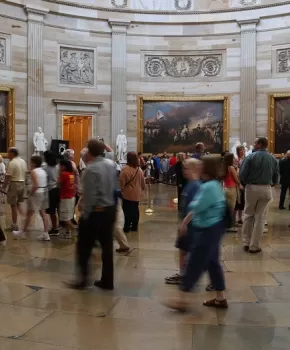
Tour groups in United States Capitol Building Rotunda - Attractions and landmarks in Washington, DC
Tours of the U.S. Capitol also need to be arranged in advance. Free reservations can be made via the visitthecapitol.gov website. Guided tours begin at the Capitol Visitor Center and include a 13-minute intro film, along with visits to the Crypt, the Rotunda and National Statuary Hall. Visitors can also request a staff-led tour through their Senator or Congress person.
When court is not in session, visitors can take free, self-guided tours of the Supreme Court . Trained docents are on-hand to give courtroom lectures every 30-minutes from 9:30 a.m. - 3:30 p.m. on weekdays. Visitors are also invited to attend oral arguments when court is in session. These seats are extremely limited. Visitors must wait in line the morning of a courtroom session. See the Visitor’s Guide to Oral Arguments page for more information.
Admission to both the Bureau of Engraving and Printing (see where U.S. dollars are made!) and the National Archives (home of the original U.S. Constitution, Declaration of Independence and Bill of Rights) are free and open to the public. In busier months, you’ll need to queue in an outdoor line to get inside.
Please visit our touring the White House guide for more information on booking a tour (Note: these tours must be booked well in advance).
Great options for guided tours
The highly acclaimed Unlimited Biking offers daily, three-hour guided bicycle tours of the monuments with stops at all of the major attractions along the National Mall. Unlimited Biking also offers tours after dark so that visitors can experience magnificent views of the attractions illuminated at night. Big Bus Tours offers open-top sightseeing tours of the National Mall. Enjoy 24 or 48-hour hop-on, hop-off tours of the city's iconic landmarks. Along the way, you can learn about the city's history while listening to the entertaining and informative commentary. Your hop-on, hop-off ticket also allows you to exit the bus to explore and visit attractions up-close. Get an exclusive discount and save big on your next Big Bus Tour . Just enter the promotional code VISITDC for the best available deal and start exploring the nation's capital.
Adventure DC Tricycle Tours offers live and entertaining historical narration as they transport you via pedicab to each monument and memorial. You can enjoy a customized tour that is pet-, child-, and mobility-impaired-friendly. Additionally, private golf cart and electric scooter tours are available. Public scooter tours are open to the general public on Saturdays, with limited availability. The code "DCFUN" will secure a discount on the public scooter tour.
Cruise around the nation's capital in style on Washington, DC Urban Adventures ' unique electric vehicles, where you can see the monuments and memorials on the National Mall by day or night.
For a truly unique way to see the city, Capital Segway Tours offers guided experiences of the National Mall and surrounding sites. Visitors glide across town on a Segway, all while taking in the sites of Washington, DC.
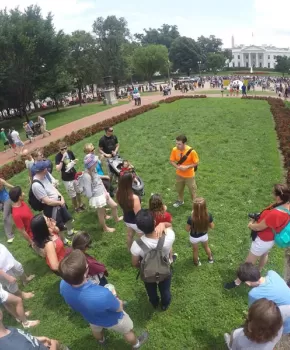
DC by Foot offers free, tip-based walking tours of Washington, DC. These informative tours are conducted by expert guides who make it fun and educational. In addition to the National Mall, DC by Foot takes visitors to the Tidal Basin, Pennsylvania Avenue and Capitol Hill. Visitors can also learn all about President Lincoln’s assassination or about Washington’s secrets and scandals.
Contact Fiat Luxe Tours for an exciting private tour experience along the National Mall. Whether you want to learn the history of DC's most iconic landmarks or find the most perfect photo-ops, Fiat Luxe Tours has a tour for you. The company also conducts custom-made tours, too.
More About DC
You may also like..
80+ Things to Do This May in Washington, DC
Things to Do This Weekend in Washington, DC
Things to Do This Week in Washington, DC
By looking to future, Supreme Court may push Trump’s D.C. trial past election

In taking on the unprecedented question of whether Donald Trump is immune from prosecution for actions he took while in office, the Supreme Court is in position to have a major say in shaping presidential power and accountability for future occupants of the White House.
But the way the justices have timed and framed the case seems likely to have a much more immediate impact, analysts say: delaying Trump’s federal trial on charges of trying to subvert the 2020 election results until after this year’s presidential election.
When the justices chose to hear the case and scheduled argument for Thursday — rather than let stand a unanimous appeals court decision that greenlighted Trump’s trial — they said they would look only at whether former presidents are shielded from prosecution for actions taken as part of their official duties.
But the special counsel’s indictment of Trump includes a mix of official conduct and private acts. That means the high court’s ruling almost certainly will create more work for the trial court judge before she can ramp up courtroom proceedings in the former president’s D.C. election obstruction case.
Even if the Supreme Court finds that Trump can be prosecuted, that additional fact-finding could sound “the death knell” for the prospects of completing his trial before the election, said a person connected to the D.C. trial court who spoke on the condition of anonymity because they were not authorized to speak publicly.
Trump, the presumptive Republican nominee, has tried to delay all his trials until after the November election, raising the prospect that if he is reelected, he could press the Justice Department to drop the federal charges against him.
While the federal courthouse in Washington spent months preparing security and other arrangements before the trial’s original March 4 start date, those efforts have ground to a halt since the Supreme Court announced on Feb. 28 that it would hear the appeal.
The latest updates on Trump’s trials
Since Trump took office in 2017, current and former government officials have worried that his penchant for high-stakes assertions of absolute power would boomerang on the government itself, resulting in court rulings or new laws from Congress that weakened the authority of future presidents.
With the immunity claims before the Supreme Court on Thursday, the judicial branch is being asked to draw a clear line about what a president can or cannot do.
The high court, with three Trump nominees, has generally not been receptive to the former president’s assertions of immunity, forcing him to comply with a subpoena and rejecting his efforts to block Congress from accessing his tax records. But close observers of the court said several of the justices also will not want to inappropriately rein in future chief executives from doing what the job requires.
At least four — Chief Justice John G. Roberts Jr. and Justices Samuel A. Alito Jr., Elena Kagan, Brett M. Kavanaugh — all of whom previously worked as lawyers in the White House or the Justice Department, are likely to be especially sensitive to the implications of their decision for future presidents.
“This litigation is massively important for the presidency far beyond Donald Trump, and the court will be worried about how a ruling on the books will impact the presidency going forward,” said Jack Goldsmith, a Harvard Law School professor who was an assistant attorney general at the Justice Department during the administration of President George W. Bush.
“It’s not an ideological thing; it’s a sensitivity to implications for any presidency beyond this issue.”
The case against Trump
Special counsel Jack Smith has charged Trump with four felonies connected to his alleged plan to overturn Joe Biden’s 2020 presidential victory: conspiring to defraud the United States, conspiring to obstruct the formal certification in Congress of Biden’s win on Jan. 6 , 2021, obstructing a congressional proceeding and conspiracy against rights — in this case, the right to vote. It is one of four trials Trump is facing; the first began earlier this month in New York.
Trump challenged the D.C. indictment, saying former presidents are immune from criminal prosecution, at least for actions related to their official duties, unless first impeached and convicted by Congress. Without that protection, Trump’s lawyers, led by D. John Sauer, said in their most recent court filing, “every future president will face de facto blackmail and extortion while in office, and will be harassed by politically motivated prosecution after leaving office, over his most sensitive and controversial decisions.”
Smith’s office pushed back, saying the absence of any other prosecution of a former U.S. president “does not reflect the understanding that presidents are immune from criminal liability; it instead underscores the unprecedented nature of [Trump’s] alleged conduct.”
There are not many cases from history for the justices to turn to for guidance to resolve the competing claims in Trump v. United States . Forty years ago, in a case involving President Richard M. Nixon, the court said the Constitution shields presidents from private civil lawsuits for actions taken as part of their official duties — even those at the “outer perimeter” of their responsibilities.
That decision aimed to ensure the threat of civil litigation did not distract from a president’s duties. But it did not address criminal liability.
The justices on Thursday will review a unanimous decision from a three-judge panel of the U.S. Court of Appeals for the D.C. Circuit that forcefully said Trump could be prosecuted for his alleged efforts to disrupt the election results. He is accused of using false claims of massive voter fraud to pressure state officials, the Justice Department and former vice president Mike Pence to change the results; scheming with others to submit to Congress slates of phony electors from swing states and to get lawmakers to toss out lawful ballots; and encouraging supporters to gather at the Capitol, where a violent mob stopped the vote count for many hours.
After the D.C. Circuit ruling, it took almost two weeks for the Supreme Court to announce that it would review the immunity case — an indication that the justices were negotiating among themselves over how to proceed.
They reframed the question they will consider at argument to address “whether and if so to what extent does a former president enjoy presidential immunity from criminal prosecution for conduct alleged to involve official acts during his tenure in office.”
No lower court has determined whether the allegations against Trump in the indictment amount to official acts that could be shielded from liability — or private conduct that presumably is not. In a footnote to the D.C. Circuit opinion, the appeals court called it “doubtful” that all the types of conduct alleged in the indictment amount to official acts.
But the Supreme Court’s highly scrutinized phrasing suggests that some justices may be interested in distinguishing between a president’s actions that are private and those that are part of official duties — and therefore may be protected by some level of immunity.
Conservative legal experts often contend that a president’s power needs to be more robust, while liberal analysts argue a commander in chief’s power must have limits imposed by the legislative branch and the courts. At Thursday’s arguments, many will be looking to see how often the six conservatives on the court raise concerns about limiting future presidents.
“The idea that the risk of prosecution ‘chills presidential action’ is not necessarily a bad thing,’’ said Brian Jacobs, a former federal prosecutor. “A ruling that Trump is not immune would preserve the criminal laws as a check on any future president’s actions — just as the criminal laws check the actions of all individuals, including all government officials — and would ensure that future presidents remain bound by the criminal laws.”
A civil example
Both Trump’s legal team and federal prosecutors contemplate in their filings at the Supreme Court the possibility of additional legal wrangling once the justices rule, which could happen any time between oral argument and the end of the term in late June or early July.
The special counsel told the justices that even if they decide a former president is entitled to some immunity, Trump’s trial could still proceed. “At the core of the charged conspiracies is a private scheme with private actors to achieve a private end: petitioner’s effort to remain in power by fraud,” the prosecutor’s office wrote.
Smith’s office and Trump’s lawyers say in their filings that the high court could send the case back to the trial court for U.S. District Judge Tanya S. Chutkan to determine how the Supreme Court’s ruling applies to the specific allegations against Trump. She would need to separate out which alleged actions count as official conduct, as opposed to a private action, a process that could include requesting legal briefs from each side over a period of weeks.
There is disagreement between the parties about whether Trump would have to wait until the conclusion of the trial to appeal whatever Chutkan decides. An appeal would set off another round of litigation at the D.C. Circuit and potentially the Supreme Court.
With little past precedent to rely on, the Supreme Court could take note of — and Chutkan could look for guidance from — a separate recent appeals court ruling that said Trump is not broadly immune from civil lawsuits filed by police officers and members of Congress seeking to hold him accountable for inciting the mob that attacked the Capitol on Jan. 6, 2021.
In the unanimous D.C. Circuit opinion written by Chief Judge Sri Srinivasan, the appeals court distinguished between an “office-seeker” and an “office-holder.”
“When a first-term President opts to seek a second term, his campaign to win re-election is not an official presidential act,” Srinivasan wrote. “The Office of the Presidency as an institution is agnostic about who will occupy it next. And campaigning to gain that office is not an official act of the office.”
The appeals court decision allows Trump to return to district court to try to show his actions before and on Jan. 6, including his speech urging supporters to march to the Capitol, were taken in his official capacity as president rather than in his unofficial capacity as a presidential candidate .
The parties are in the process of gathering and sharing evidence, an undertaking that could last several months, before the district court judge can decide whether Trump was acting in an official capacity, or as a candidate and not entitled to immunity.
Devlin Barrett, Spencer S. Hsu and Carol D. Leonnig contributed to this report.
Trump New York hush money case
Former president Donald Trump’s criminal hush money trial is underway in New York. Follow live updates from the trial .
Jury selection: A full jury of 12 jurors and six alternates has been seated. Here’s what we know about the jurors .
The case: The investigation involves a $130,000 payment made to Stormy Daniels, an adult-film actress , during the 2016 presidential campaign. It’s one of many ongoing investigations involving Trump . Here are some of the key people in the case .
The charges: Trump is charged with 34 felony counts of falsifying business records. Falsifying business records is a felony in New York when there is an “intent to defraud” that includes an intent to “commit another crime or to aid or conceal” another crime. He has pleaded not guilty . Here’s what to know about the charges — and any potential sentence .
Can Trump still run for president? The short answer, legal experts said, is yes. The U.S. Constitution does not forbid Trump, or anyone else, from serving as president if convicted of a felony.
- Supreme Court seems poised to allow Trump Jan. 6 trial, but not immediately April 25, 2024 Supreme Court seems poised to allow Trump Jan. 6 trial, but not immediately April 25, 2024
- The chief justice hated Trump appeals court decision, and other takeaways April 25, 2024 The chief justice hated Trump appeals court decision, and other takeaways April 25, 2024
- Highlights from Supreme Court arguments over Trump’s immunity claim April 25, 2024 Highlights from Supreme Court arguments over Trump’s immunity claim April 25, 2024

- Election 2024
- Entertainment
- Newsletters
- Photography
- Personal Finance
- AP Investigations
- AP Buyline Personal Finance
- AP Buyline Shopping
- Press Releases
- Israel-Hamas War
- Russia-Ukraine War
- Global elections
- Asia Pacific
- Latin America
- Middle East
- Election Results
- Delegate Tracker
- AP & Elections
- Auto Racing
- 2024 Paris Olympic Games
- Movie reviews
- Book reviews
- Personal finance
- Financial Markets
- Business Highlights
- Financial wellness
- Artificial Intelligence
- Social Media
Protesters gathered outside the U.S. Supreme Court building in Washington Thursday as the court hears arguments over whether Donald Trump should be immune from prosecution for actions he took during his time as president.
Protests outside U.S. Supreme Court in Washington as it hears Donald Trump’s immunity case
- Copy Link copied

The Busch School of Business
Msb students receive unexpected welcome from chief justice john roberts during supreme court visit.

In a surprising turn of events during a trip to the Supreme Court, our MSB students received a special visit from Chief Justice John Roberts. The visit, intended to be a tour to learn more about the history of the Supreme Court, turned into an impromptu Q&A session where Chief Justice Roberts answered a variety of questions from the students, to broaden their understanding of law, especially in the world of business.
The day began with a tour led by an experienced guide who shared insights into the history of the Supreme Court. As the students learned more and entered the courtroom, Chief Roberts made his unexpected appearance, greeting the students and eager to answer their questions.
The MSB's trip to the Supreme Court not only showcased the benefits of being right here in Washington, D.C. but also highlighted the significance of experiential learning for students taking business law courses.
Learn more about our MSB program
- Share on Facebook
- Share on Twitter
- Share on LinkedIn

Cambodia’s Supreme Court upholds the 2-year prison sentence of a casino strike leader
The Associated Press
May 3, 2024, 7:15 AM
- Share This:
- share on facebook
- share on threads
- share on linkedin
- share on email
PHNOM PENH, Cambodia (AP) — Cambodia’s Supreme Court on Friday upheld the two-year prison sentence of a labor union leader who led a long-running strike against the country’s biggest casino.
Chhim Sithar, president of the Labor Rights Supported Union of Khmer Employees of NagaWorld, had originally been convicted in May 2023 of incitement to commit a felony.
She had been leading a strike that began in December 2021 to protest mass layoffs and alleged union-busting at the NagaWorld casino in the capital, Phnom Penh, and was arrested and charged after a January 2022 demonstration of dismissed employees who were demanding to be rehired,
NagaWorld in late 2021 had fired 373 employees amid financial struggles related to the coronavirus pandemic.
Some dismissed workers continue to hold regular protests, appealing for Chhim Sithar to be released and for them to get their jobs back, Am Sam Ath of the rights groups Licadho said Friday. More than 200 others had accepted compensation under the labor law and dropped their demands, the Ministry of Labor and Vocational Training announced in December 2022.
Supporters of Chhim Sithar gathered outside the Supreme Court on Friday with banners calling for her release on appeal. The court also upheld the convictions and sentences of eight of her fellow union members. Five received sentences of 1 1/2 years each. Three others had been given suspended sentences of one year each.
Chhim Sithar could be released later this year when her prison term ends due to time already served before her conviction.
NagaWorld is owned by a company controlled by the family of Malaysian billionaire Chen Lip Keong. The company received its casino license in 1994 and the property is now a huge integrated hotel-casino entertainment complex.
Labor union actions had not been rare in Cambodia but usually had taken place at factories in outlying areas or in industrial estates in other provinces. The protest by the NagaWorld workers in the capital was unusually high-profile and drew police action that was sometimes violent.
In February last year, the U.S. Department of State named Chhim Sithar among 10 recipients around the globe of its annual Human Rights Defender Award. She was described by U.S. Ambassador to Cambodia W. Patrick Murphy as “a courageous and tenacious labor union leader who peacefully advocates for the rights of Cambodian workers.”
Copyright © 2024 The Associated Press. All rights reserved. This material may not be published, broadcast, written or redistributed.
Related News

Mexican officials say 3 bodies recovered in Baja California during search for 3 missing foreigners

Mexican officials say 3 bodies found in Baja California area where 2 Australians and American went missing

Flood and landslide hit Indonesia’s Sulawesi island, killing 14
Recommended.

Montgomery Co. horseback riding center announces closure in July
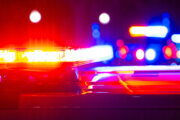
Young girl shot in Southeast DC

First legal DC marijuana patio to open 'any day now'
Related categories:.

IMAGES
COMMENTS
Cafeteria, Gift Shop, and Building Amenities. A Cafeteria serving a variety of sandwiches, soups, salads, and beverages is open to the public from 7:30 a.m. until 4 p.m., Monday through Friday. A Gift Shop is located on the Ground Floor and is open from 9 a.m. until 4:25 p.m., Monday through Friday.
The Supreme Court Building is open to the public Monday - Friday from 9 a.m. to 3 p.m. It is closed on weekends and all federal holidays. In addition to the Courtroom, portions of the first and ground floors of the Supreme Court Building are open to the public. Visitors should be aware that the business of the Court may affect public access ...
Before entering the Supreme Court Building, all visitors are screened by a magnetometer and all personal belongings are screened by an x-ray machine. To ensure the safety of visitors and staff and to preserve the collections, facilities, and historic building and grounds, please see the list of items strictly prohibited inside the building and ...
The Supreme Court Building is located at 1 First Street St NE across the street from the US Capitol Building and the Library of Congress. Use this link for directions to the Supreme Court . Or let us take you here on one of our pay-what-you-like Capitol Hill Tours. It is a 7 min walk from the Capitol South Station Metro ( Blue, Orange, Silver ).
Self-Guides. Use the following guides to enhance an on-site visit or learn about the Supreme Court Building from home. See Architectural Information for more detailed descriptions of the building's architectural features and highlights. Look closely and take in the East and West Pediments, the Fraser statues flanking the front steps, the ...
6 Stop 6 open 9am-4:30 pm. Free. Share: Email Print. Upon arrival at the Supreme Court, visitors are often struck by the imposing marble building. Architecturally magnificent, the neoclassical structure was built in 1935 to become the permanent home to the Supreme Court. Walking along the hallway towards the Courtroom, guests are greeted by ...
Open Mon.- Fri. 9 am - 4:30 pm. Lectures in the courtroom are given every hour on the half hour 9:30 am - 3:30 pm when court is not in session. Admission: Free.
The building also hosts rotating exhibitions from time to time. Sadly, no visitors are permitted to the "highest court in the land"—the indoor basketball court on the top floor. Closed Saturday, Sunday, and federal holidays. 1 First St., NE; 202-479-3000. This article appears in Washingtonian's Welcome Guide.
The tour includes the Crypt, Rotunda, National Statuary Hall, the Old Supreme Court Chamber, and the Old Senate Chamber. The tour will have live video and audio with time for questions and answers. These online tours are available upon request by emailing [email protected]. Tours are 45-60 minutes, including time for questions and answers.
Supreme Court. 1st Street NE, between East Capitol Street and Maryland Ave., Washington, DC 20036, USA. 202 479-3000 or 202 479-3030 (recording) Mon-Fri 9am4:30pm.
Supreme Court. 1,517 reviews. #34 of 642 things to do in Washington DC. Government Buildings. Open now. 9:00 AM - 4:30 PM. Write a review. About. A Corinthian-style building where the final guardians of the Constitution deliberate.
Washington, DC. The highest court in the USA occupies a pseudo-Greek temple protected by 13,000lb bronze doors. Arrive early to watch arguments (periodic Monday through Wednesday from October to April). You can visit the permanent exhibits and the building's two five-story, marble-and-bronze spiral staircases year-round.
1st & E. Capitol Streets NE. Telephone: 202.479.3000. Admission: Free. Hours: 9:00 AM - 4:30 PM. The Supreme Court is the highest Court in the land, and is made up of nine justices who are appointed for life terms. The Court convenes on the first Monday in October and stays in session until it has heard all of its cases and handed down all of ...
Things to do in Washington DC; Supreme Court of the United States; Supreme Court of the United States. Free admission. 1 First St. NE, Washington DC, 20543. ... If you'd like to watch the Supreme Court in action, visit while the justices are hearing cases. Seating in the first-floor courtroom is on a first-come, first-served basis. Before a ...
The Supreme Court Building houses the Supreme Court of the United States, the highest court in the federal judiciary of the United States.The building serves as the official workplace of the chief justice of the United States and the eight associate justices of the Supreme Court.It is located at 1 First Street in Northeast Washington, D.C. It is one block immediately east of the United States ...
The Supreme Court is open to the public every Monday through Friday from 9:00 a.m. to 4:30 p.m. Lectures are held in the courtroom every hour, on the half hour, from 9:30 a.m. to 3:30 p.m. when the Court isn't sitting. Admittance to join is decided on a first-come, first-served basis. The Court is closed during all federal holidays, and Court ...
U.S. Supreme Court Tours Please note that the Supreme Court is currently closed to the public. ... visitors should anticipate longer wait times to enter the building due to larger crowds visiting the Nation's Capital. ... Washington DC Office. 2371 Rayburn HOB. Washington, DC 20515. Phone: (202) 225-4422.
The Supreme Court also has exhibitions on the history of the building, the Justices and the work of the Court. All exhibitions and the theater are located on the Ground Floor. At the theater, you can watch The Supreme Court, a 24-minute film examining the history of the building. Showings are continuous from 9:15 am until 3:45 pm.
Vending machines are also available on the ground floor. If you are bringing a group to visit, please call the Cafeteria manager at 202-479-3246 for information about arranging lunch. A Gift Shop is located on the ground floor and is open from 9 a.m. until 4:25 p.m., Monday - Friday. The Gift Shop features extensive offerings of books and ...
When court is not in session, visitors can take free, self-guided tours of the Supreme Court. Trained docents are on-hand to give courtroom lectures every 30-minutes from 9:30 a.m. - 3:30 p.m. on weekdays. Visitors are also invited to attend oral arguments when court is in session. These seats are extremely limited.
The justices on Thursday will review a unanimous decision from a three-judge panel of the U.S. Court of Appeals for the D.C. Circuit that forcefully said Trump could be prosecuted for his alleged ...
Civil rights leaders from around the nation gathered in Washington, D.C., Friday to protest book bans and rising attacks on diversity, equity and inclusion (DEI), saying limitations on education ...
Protesters gathered outside the U.S. Supreme Court building in Washington Thursday as the court hears arguments over whether Donald Trump should be immune from prosecution for actions he took during his time as president. Menu. Menu. World. U.S. Election 2024. Politics. Sports. Entertainment. Business. Science. Fact Check. Oddities. Health.
In a surprising turn of events during a trip to the Supreme Court, our MSB students received a special visit from Chief Justice John Roberts. The visit, intended to be a tour to learn more about the history of the Supreme Court, turned into an impromptu Q&A session where Chief Justice Roberts answered a variety of questions from the students, to broaden their understanding of law, especially ...
The Supreme Court wrestled Monday for more than two and a half hours with the issue of ticketing homeless people is a "cruel and unusual" punishment that violates the Eighth Amendment.
PHNOM PENH, Cambodia (AP) — Cambodia's Supreme Court on Friday upheld the two-year prison sentence of a labor union leader who led a long-running strike against the country's biggest casino.
Put on your walking shoes and pack your wanderlust: More than 55 embassies and cultural centers will open their doors this weekend, as part of Events DC's annual Around the World Embassy Tour on Saturday, May 4 from 10 AM to 5 PM. While each country has something unique to offer, we're especially excited to visit these seven:. Sri Lanka